
Love health, fitness, or wellness? Start a blog! No medical degree needed—just share what you know in your unique way.
✅ Earn passive income
✅ Work from anywhere
✅ Help others live healthier
Many health bloggers make great money while enjoying flexible schedules. See real successful health blogs for inspiration.
Your journey starts with one post. Why not make it today?
7 Powerful Benefits of Health Blogging:
- Brand Opportunities – Companies will pay you to review their wellness products
- Low Startup Costs – Begin for just $3.5/month (less than your daily coffee!) See exact pricing
- Serious Earning Potential – Top bloggers make $3,000 – $12,000+/month through:
- Affiliate marketing (earn commissions)
- Display ads (passive income)
- Sponsored content (brand partnerships)
- No Medical Degree Needed – Share your personal health journey or research-backed tips
- Global Reach – Help people worldwide improve their wellbeing
- Work From Anywhere – Manage your blog between gym sessions or while traveling
- Automatic Growth – Old posts keep earning while you sleep
Essential Requirement to Get You Started
Here are the things you need to set up a standard health & wellness blog and get it ready to start publishing your first blog post;
- Computer – Any laptop/desktop to manage your site
- Domain – Pick a catchy .com name (ex: “CleanEatingGuide.com”)
- WordPress – Free, easy-to-use platform
- Hosting – Start with HostGator for:
• Free domain
• 1-click WordPress setup
• 24/7 support - You can be up and running in under 30 minutes!
Tip: When signing up with a hosting provider like HostGator, you’ll get easy access to use WordPress directly within your account. This means you can start building and managing your blog instantly with all the features WordPress has to offer.
Affiliate Disclosure: This post may include affiliate links with special discounts. Using them saves you money and supports our site at no extra cost to you. Win-win right! Check out our [Privacy Policy] for more details. Thanks for your support!
How To Start A Health & Wellness Blog Step-by-Step
Follow these easy steps to launch your health & wellness blog with HostGator—one of the best beginner-friendly web hosting platforms.
- Step 1: Start within a health & wellness sub-niche
- Step 2: Click on HostGator to get started
- Step 3: Pick a HostGator hosting plan
- Step 4: Choose your domain name
- Step 5: Set your billing term
- Step 6: Create your HostGator account
- Step 7: Install WordPress
- Step 8: Choose a blog theme
- Step 9: Customize pages and start posting
Step 1: Start by Choosing a Health-related Sub-niche
Focusing on a specific sub-niche in the health & wellness space helps you build authority and connect with a more targeted audience. Start by picking one specific area to dive into, and as you grow, you can expand into other related topics for fresh content ideas.
Here are some popular health blogging sub-niches to consider :
- Healthy Eating and Nutrition: Recipes, meal plans, tips for healthy grocery shopping, and breakdowns of different dietary approaches (e.g., vegetarian, paleo).
- Mental Health: Address mental health-related topics such as stress management, anxiety, depression, mindfulness, and therapy. Content might include coping strategies, self-care tips, and mental health resources.
- Natural Health and Remedies: Information on alternative therapies, herbal remedies (with disclaimers to consult a doctor before use), and natural approaches to common ailments.
- Disease Prevention and Management: Tips for healthy habits that can reduce the risk of chronic diseases, information on specific conditions (with emphasis on consulting a doctor for diagnosis and treatment).
- Healthy Aging: Focus on issues related to aging, such as maintaining physical health, cognitive function, and managing age-related conditions. Topics may include exercise for seniors, anti-aging skincare, and longevity tips etc.
- Self-Care and Healthy Habits: Techniques for relaxation, getting enough sleep, establishing healthy boundaries, and prioritizing self-care routines.
- Healthy Living Inspiration: Personal stories about overcoming health challenges, success stories of healthy lifestyle changes, and articles promoting a positive and healthy outlook.
And much more – Here are some health & wellness blog post topic ideas in different sub-niches
Step 2: Ahead Over to “HostGator” To Get Started
Using our HostGator discount link, you can get HostGator for a lower price, plus a free domain name of your choice.
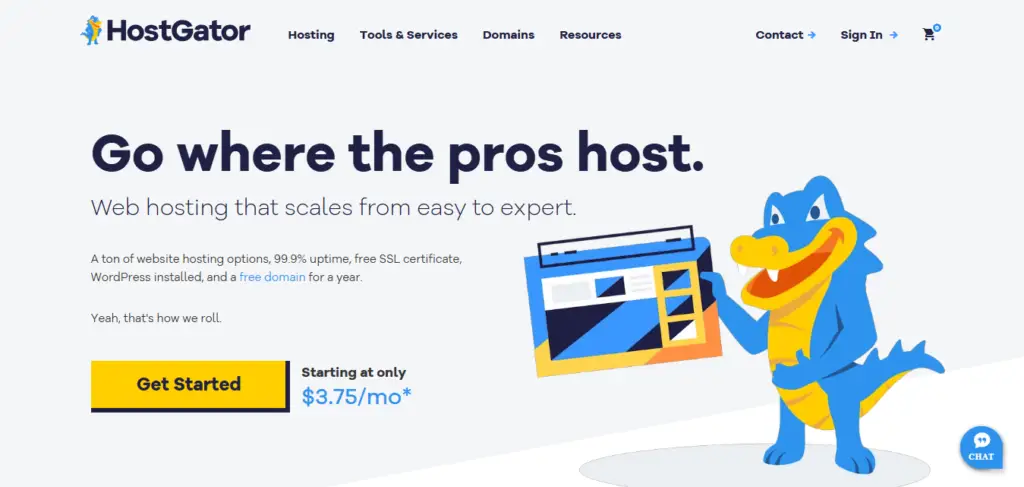
Relevant: You might also want to explore other trustworthy web hosting providers that can meet your specific needs.
Step 3: Select Your HostGator Hosting Plan
Choosing the HostGator Hatchling plan is a smart and budget-friendly choice. As a beginner, you don’t need a pricey plan—this one covers everything you need to start. You can always upgrade later as your traffic and income grow.
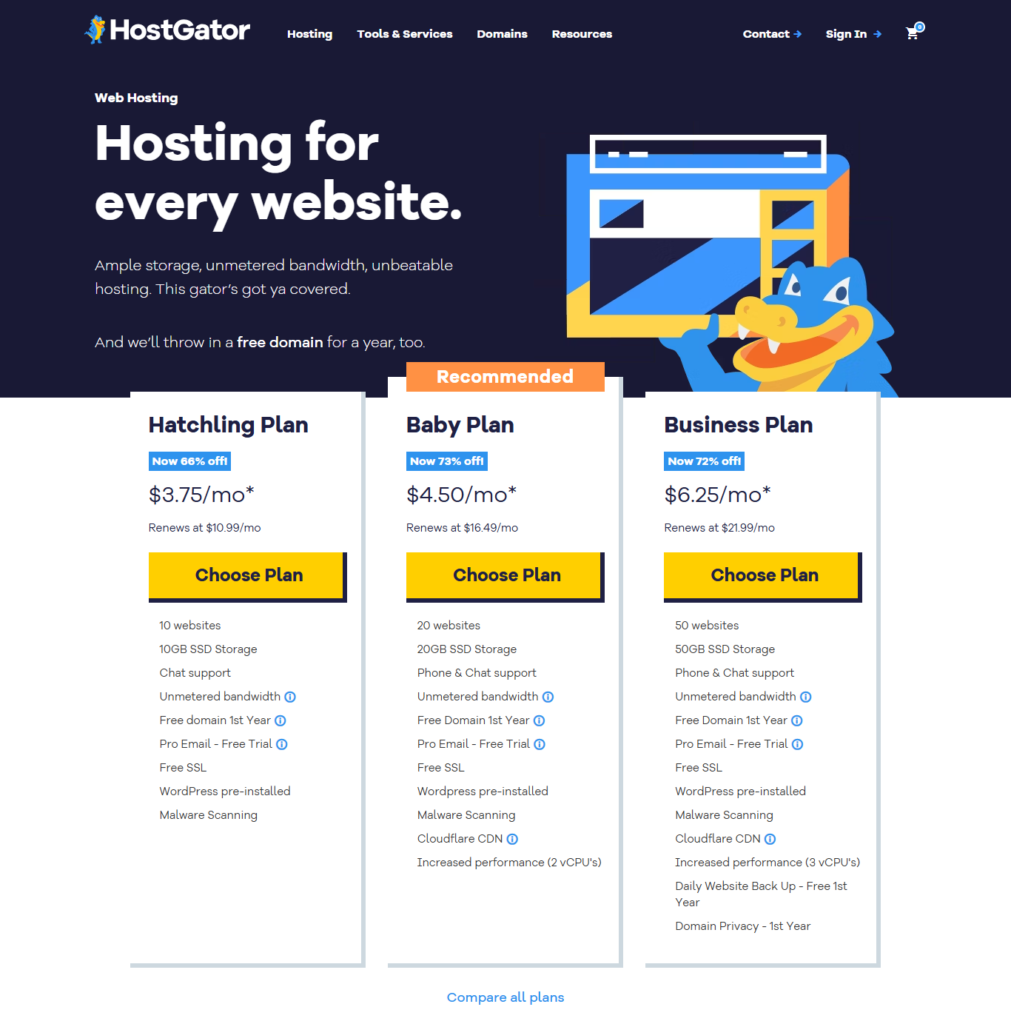
Step 4: Come up With a Domain Name of Your Choice
After picking your hosting plan, you’ll land on a setup page like the one below where you can choose your domain name and finish your sign-up in just a few steps.
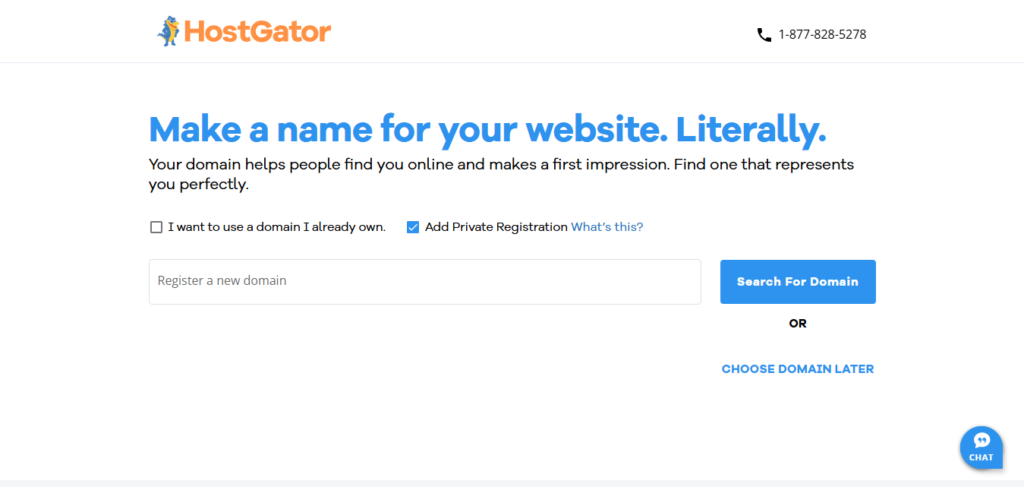
Tips for Choosing Your Health & Wellness Blog Domain Name
- Keep It Simple & Memorable: Choose a name that’s easy to spell, remember, and share—avoid hyphens or complicated words.
- Reflect Your Niche: Use health-related keywords like “wellness,” “fitness,” “nutrition,” or “healthy” so visitors instantly know what your blog is about.
- Keep It Short: Aim for 6–14 characters. Short names are easier to type and more user-friendly.
- Make It Easy to Say: Pick something that sounds natural and is easy to pronounce to encourage word-of-mouth sharing.
A well-chosen domain name is the first step toward building a memorable and successful health and wellness blog!
Relevant Post – Find More Than 200 Health-related Blog Name Ideas And Their Meaning.
Step 5: Adjust Your Hosting Subscription Period
Ensure you’re selecting the Hatchling Plan on the right-hand side. Then, adjust your subscription period to your preference, either 1 year or 36 months, based on what you can afford right now. Longer subscription periods often offer a better value, but the choice is yours!
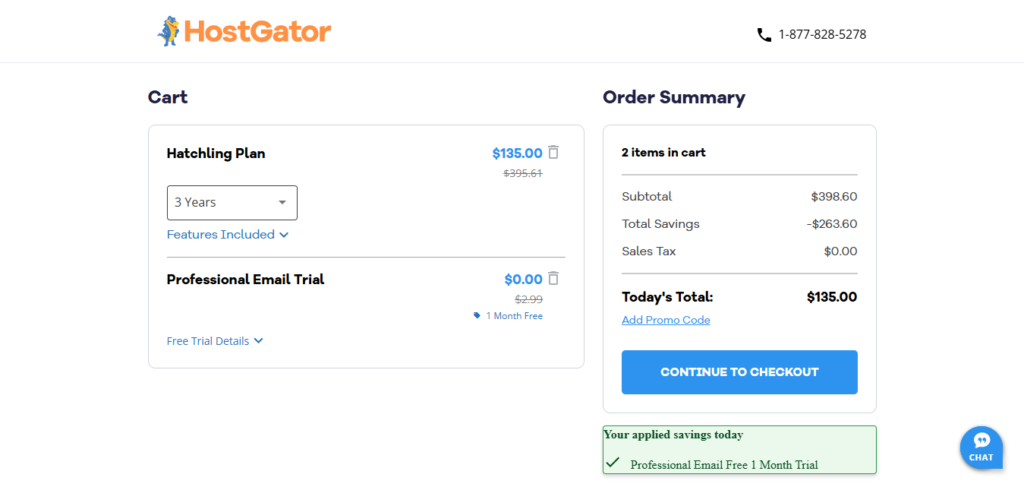
Step 6: Create Your HostGator Account
To set up your HostGator account, simply enter your email address and create a strong password to secure your login.
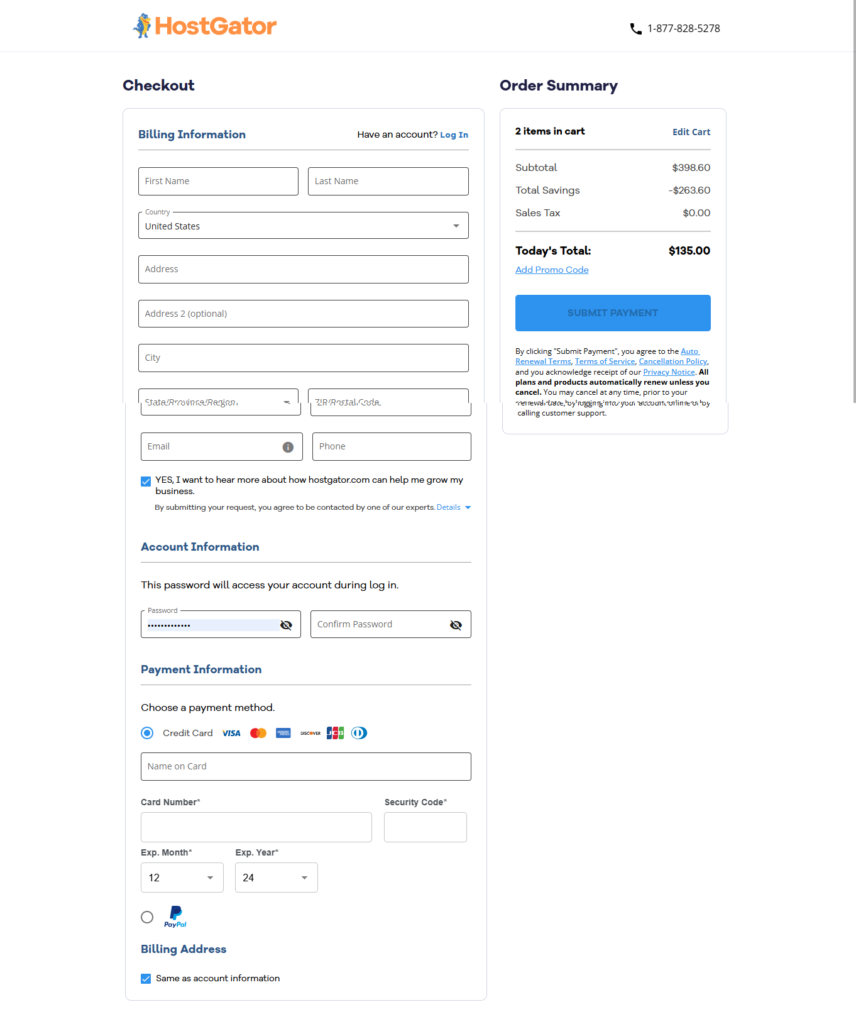
Before proceeding, make sure to review the info you’ve entered and finalize your purchase.
Step 7: Install WordPress on Your HostGator Account
Once your HostGator sign-up is complete, follow the on-screen instructions to install WordPress on your site.
Alternative Method to Install WordPress:
- Log in to your HostGator account.
- Go to the “WordPress” section in your dashboard.
- Click to set up your WordPress account.
- You’ll be automatically logged in and ready to customize your blog and start posting.
Now you’re all set to start designing your health and wellness blog.
Step 8: Choose Your Blog Theme in WordPress (Pre-built Site)
WordPress offers a variety of pre-built themes to choose from this will help you get started quickly. These themes are website templates designed to make your blog look professional without the need for custom coding or starting your site design from scratch.
Here’s how to choose and customize your theme:
- Navigate to Themes: In your WordPress dashboard, go to Appearance > Themes.
- Explore Theme Options: Browse through available themes, keeping in mind your niche—health and wellness. Look for themes that are clean, easy to navigate, and visually appealing to your target audience.
- Preview the Theme: Click the Preview button to see how the theme looks with your content and check how it appears on both desktop and mobile devices.
- Choose and Install: Once you find a theme you like, click Install to add it to your blog.
- Customize Your Theme: Go to Appearance > Customize to tweak colors, fonts, and layouts, ensuring it reflects your blog’s vibe and aligns with your health and wellness content.
Here are recommended themes for health-related blogs:
- Divi (Highly customizable, ideal for health content)
- Astra (Highly customizable, fast, and mobile-friendly)
- Wellness Pro (Perfect for health and wellness blogs with a professional design)
Choosing a theme that matches your health & wellness brand will make it easier for your audience to navigate your site, read your blog posts, and have a good experience!
Step 9: Customize Your Blog and Start Posting
- Personalize your blog! Use your theme’s customization options to tweak colors, fonts, and layouts to match your style.
- Most themes come with built-in templates for essential pages like “About,” “Contact,” and “Home.” You can easily adjust these to fit your vision.
- Once your pages are set up, it’s time to start writing and publishing posts.
Congrats! You’ve created a fully functional blog ready for any type of health-related blog post. Your blog is now live and visible on Google and the web.
Follow the Video Below
This video will guide you through setting up your WordPress blog with HostGator.
Once you’ve completed your blog site, you can then follow the steps below to find health-related blog topic ideas to write about and monetize to make money.
How to Find Health Blog Topics to Write About
To build a successful health blog that attracts traffic and generates income, you need to create valuable content that resonates with your audience.
Here’s how to find the perfect blog topics for your health blog.
- Trending Topics: Use tools like Google Trends or health forums to spot popular discussions (e.g., “gut health hacks”).
- Answer FAQs: Address questions like “How to lower cholesterol naturally?”—timeless and SEO-friendly.
- Competitor Gaps: Analyze top health blogs (like Wellness Mama) for untapped angles.
- Keyword Tools: Try Ubersuggest to find low-competition keywords.
- Audience Polls: Ask followers on social media or blog comments for ideas.
Relevant Post: Health Blog Topic Ideas
How to Write & Optimize Health Blog Posts
1. Craft Engaging Content
- Hook readers fast: Start with a relatable problem (e.g., “Struggling to sleep? Try these science-backed tips.”).
- Structure for clarity: Use subheadings, bullet points, and short paragraphs. See best blog post formats.
- Keep it conversational: Avoid jargon—write like you’re advising a friend.
- Add visuals: Use images or infographics to simplify complex topics (e.g., workout steps).
- End with a CTA: Ask readers to comment, share, or check related posts.
Pro Tip: Dive deeper with our high-quality blog writing guide.
2. Write Click-Worthy Headlines
- Be specific: “7 Proven Ways to Boost Energy (No Caffeine Needed!)”
- Use keywords: Include terms like “mental health tips” for SEO.
- Spark curiosity: “The Morning Routine That Changed My Health”
More tips: How to write irresistible headlines.
3. Hire a Skilled Writer (If Needed)
- Find niche experts: Platforms like Upwork or Fiverr.
- Review samples: Ensure their style matches your blog’s voice.
- Provide clear guidelines: Share topic outlines and tone preferences.
Guide: Hiring the right blog writer.
How to Monetize Your Health Blog
1. Display Ads (Passive Income)
Best for beginners: Start with Google AdSense—it’s free and easy to set up.
- How it works: Earn money when readers view or click ads.
- Earnings: $500–$3,000+/month (depends on traffic).
- Pro tip: Wait until you have 10–30 posts before applying.
Upgrade later: Switch to premium ad networks like Mediavine (50K+ monthly visits).
→ More ad network options
2. Affiliate Marketing (High Earnings)
Promote health products and earn commissions (5%–40% per sale).
Top programs for health bloggers:
- Amazon Associates (fitness gear, books)
- iHerb (supplements, vitamins)
- ShareASale (wellness brands)
- MindBodyGreen (holistic health)
How to succeed:
- Write honest product reviews (e.g., “Best Protein Powders for Weight Loss”).
- Create “Best of” lists with affiliate links.
- Add links in how-to guides (e.g., “Yoga Gear for Beginners”).
Earnings: $1,000–$12,000+/month (top bloggers make six figures).
→ Affiliate content ideas
Bonus Strategies
- Sell digital products: Meal plans, eBooks, or online courses.
- Sponsorships: Partner with brands (needs 10K+ followers).
Pro tip: Combine ads + affiliates for max income. Example:
“Review a blender (affiliate link), then recommend your smoothie eBook.”
→ Full monetization guide
→ Success stories
Key takeaway: Focus on value first—money follows traffic!
How Much Money Do Health & Wellness Blogs Make?
Here’s how much health & wellness blogs make, in different categories.
These are estimates and average required numbers.
- Average time required
- Average required traffic
- Average monthly income
- Common methods of monetization
- Average published number of posts
[a]. Beginner Health & Wellness Blogs
- Income: $500 – $1,500 per month
- Traffic: 2,6000 – 8,000 visitors per month
- Number of Posts: 25 – 60 posts
- Time required: 6 months – 1 year
- Common Methods of Monetization:
- Display ads (Google AdSense)
- Affiliate marketing (wellness products, supplements, fitness gear)
Beginners focus on building content and slowly monetizing through affiliate links and ads.
[b]. Average Health & Wellness Blogs
- Income: $3,400 – $11,500 per month
- Traffic: 15,000 – 75,000 visitors per month
- Number of Posts: 80 – 500 posts
- Average required time: 1 – 2 years
- Common Methods of Monetization:
- Affiliate marketing (wellness products, vitamins, fitness programs)
- Display ads (via networks like Mediavine or AdThrive)
- Sponsorship deals with health niche-related brands
By this stage, the blog may have built authority, increasing affiliate commissions and ad earnings.
[c]. Established Health & Wellness Blogs
- Income: $15,000 – $100,000+ per month
- Traffic: 100,000 – 500,000+ visitors per month
- Number of Posts: 1,500+ posts
- Average required time: 3 – 5+ years
- Common Methods of Monetization:
- High-ticket affiliate marketing (health equipment, premium supplements)
- Selling online courses (yoga, meditation, fitness, nutrition)
- Premium ad display networks (Ezoic, Mediavine, AdThrive) or direct ad sales to brands
- Sponsored partnerships with large health companies
- Coaching or consulting
Established blogs attract high traffic, sponsorship deals, and even launch their own products like fitness gear or health apps.
Relevant Post – Health Blog Income Reports To Inspire Your Journey
4 Inspiring Health & Wellness Blogs That Make Serious Money
These successful sites prove it’s possible – here’s how they do it:
1. The Balanced Life
Niche: Pilates & mindful fitness
Why It Works:
- 💰 $30K–$50K/month from memberships + affiliate marketing
- 🎥 Free workout videos build trust before selling premium programs
- 🤝 Partners with brands like Lululemon for sponsored content
Key Takeaway: Combine free value with paid offerings.
2. Fit Bottomed Girls
Niche: Body-positive fitness
Secrets to Success:
- 📻 Podcast sponsorships + book deals boost income to $20K–$40K/month
- 😊 Relatable tone (“Fitness for real women”) builds loyal community
- 🛍️ Affiliate links to inclusive activewear brands
Key Takeaway: Personality + multiple income streams = profit.
3. Nerd Fitness
Niche: Gamified fitness for “nerds”
Winning Strategy:
- 🎮 Online courses + coaching generate $45K–$80K/month
- 🎯 Ultra-specific audience (gamers, comic fans) = less competition
- 🤓 Fun approach (“Level Up Your Life”) converts readers to buyers
Key Takeaway: Niche down and gamify your content.
4. Wellness Mama
Niche: Natural family wellness
Income Powerhouse:
- 🏆 $70K–$150K/month from courses + own product line
- 🧴 DIY recipes (like homemade sunscreen) go viral on Pinterest
- 📚 Authority content ranks for 100K+ keywords
Key Takeaway: Build a brand beyond blogging.
What You Can Learn From These Blogs
- Mix free & paid content (e.g., free recipes → paid meal plans)
- Go niche (yoga for runners > generic fitness)
- Diversify income (ads + affiliates + digital products)
Want more case studies? See our full list of profitable health blogs and income reports.
How to Drive Traffic to Your Health Blog (Made Simple)
Getting visitors to your health blog isn’t just about writing—it’s about sharing your content the right way.
Here’s how to grow your traffic step by step:
1. Boost Traffic with SEO
Search Engine Optimization (SEO) helps people find your blog on Google.
- Find the Right Keywords: Use tools like Google Keyword Planner or Ubersuggest to see what people are searching for (e.g., “meal prep for weight loss” or “easy home workouts”).
- Use Keywords Naturally: Add your keywords to your blog titles, headings, meta descriptions, and image alt text.
- Structure Your Content Well: Use clear headings (H1, H2, H3) and break up your content into easy sections. Learn more in this guide on how to format a blog post.
- Get Backlinks: Backlinks are links from other websites to your blog. You can get them by writing guest posts or collaborating with other bloggers. Use this guide to build backlinks the right way, and find guest posting sites here.
📌 Learn more: How to Increase Your Blog Traffic
2. Promote Your Blog on Pinterest
Pinterest works well for health and wellness blogs because people love visual content.
- Create Eye-Catching Pins: Use clear, bright images with text overlays that make people want to click.
- Use Keywords in Pin Descriptions: This helps your pins show up when people search.
- Pin Consistently: Post regularly so your content stays active and visible.
3. Use Quora to Share Your Expertise
Quora is a Q&A site where people look for helpful answers.
- Find Health-Related Questions: Search for topics like “how to get better sleep” or “best foods for energy.”
- Give Detailed Answers: Offer real value and link back to your blog when it fits naturally.
- Be Consistent: The more you show up, the more authority you build—and more people will check out your blog.
4. Join Reddit Discussions
Reddit has active health communities (called subreddits) like r/health, r/Fitness, and r/nutrition.
- Share Tips, Not Just Links: Give genuine advice and only link your blog when it truly helps the conversation.
- Try Hosting an AMA: If you’re knowledgeable in a health topic, host an “Ask Me Anything” to share your insights and blog content.
5. Be Active in Facebook Groups
Facebook groups are full of people looking for health advice and community.
- Join Relevant Groups: Look for active groups related to your niche (e.g., plant-based eating, home workouts, mental wellness).
- Be Helpful First: Answer questions, join discussions, and share your blog posts when appropriate.
- Use Facebook Ads (Optional): Promote your best content with targeted ads if you have a small budget.
📌 Read: How to Promote Your Blog
Final Thoughts
Getting traffic doesn’t happen overnight. But by combining SEO, Pinterest, Quora, Reddit, and Facebook groups, you’ll start building a steady stream of visitors to your health blog.
Just stay consistent and keep helping your readers—your traffic will grow over time!
Useful Resources:
- How to Increase Blog Traffic
- How to Promote Your Blog
- How to Format Your Blog Posts
- How to Get Backlinks
- Guest Posting Sites List
Quick Summary
Starting a health and wellness blog doesn’t have to be overwhelming. Follow these quick step a summary of what we’ve covered already to get you up and running:
✅ 1. Pick Your Niche: Choose one clear topic to start with—such as fitness, mental health, or clean eating. Focusing on a specific niche helps you stand out and attract the right readers.
👉 Explore profitable blog niches
✅ 2. Set Up Hosting with HostGator: You need web hosting to make your blog live on the internet. HostGator is reliable, beginner-friendly, and budget-friendly.
👉 Get started with HostGator
✅ 3. Choose a Hosting Plan: Pick a plan based on your needs. For beginners, the basic shared hosting option is usually enough.
✅ 4. Pick a Domain Name: Your domain should reflect your health niche. Make it easy to remember, like fitwithjane.com or mindfulmeals.net.
✅ 5. Install WordPress: Most hosting providers, including HostGator, let you install WordPress with one click. It’s the easiest platform to manage your blog.
✅ 6. Choose a Clean Blog Theme: Select a theme that’s mobile-friendly and easy to navigate. Look for a simple, clean design that’s ideal for health-related content.
✅ 7. Set Up Core Pages: Create the essential pages:
- About – Tell readers who you are.
- Contact – Make it easy for people to reach you.
- Blog – Where all your posts will live.
✅ 8. Start Publishing Blog Posts: Write helpful, well-formatted blog posts on topics your readers care about. Keep things simple, clear, and valuable.
👉 Need help formatting? Here are 7 proven blog post formats
Other Types of Blogs You May Consider Starting
If you’re enjoying health blogging, you might love these other profitable niches:
Health & Wellness Adjacent Niches
- How to Start a Fitness Blog (Monetize workout plans and supplement reviews)
- How to Start a Beauty/Makeup/Skincare Blog (Perfect for holistic wellness bloggers)
- How to Start a Food/Recipe/Baking Blog (Healthy eating and nutrition focus)
- How to Start an Outdoor Blog (Hiking, nature therapy, and adventure wellness)
Lifestyle & Personal Growth
- How to Start a Lifestyle/Personal Blog (Broaden to self-improvement topics)
- How to Start a Mom/Parenting Blog (Family health and child wellness angle)
- How to Start a Coaching Blog (Monetize your health expertise 1-on-1)
Creative & Passion-Based Blogs
- How to Start a DIY [Craft & Home DIY] Blog (Wellness through creative projects)
- How to Start a Photography Blog (Health transformation photos, food photography)
- How to Start a Literature [Book & Poetry] Blog (Mental health through writing)
Special Interest Niches
- How to Start a Travel Blog (Wellness retreats and healthy travel tips)
- How to Start a Fashion Blog (Athleisure and body-positive style content)
- How to Start a Wedding Blog (Bridal wellness and pre-wedding health plans)
Pro Tip: Many of these use similar monetization methods to health blogs – ads, affiliates, and digital products work across niches!





![How To Get Backlinks Fast To Your Blog or Website [Free]](https://inwebmastro.com/wp-content/uploads/2024/12/pexels-karolina-grabowska-8546800-200x300.jpg)



